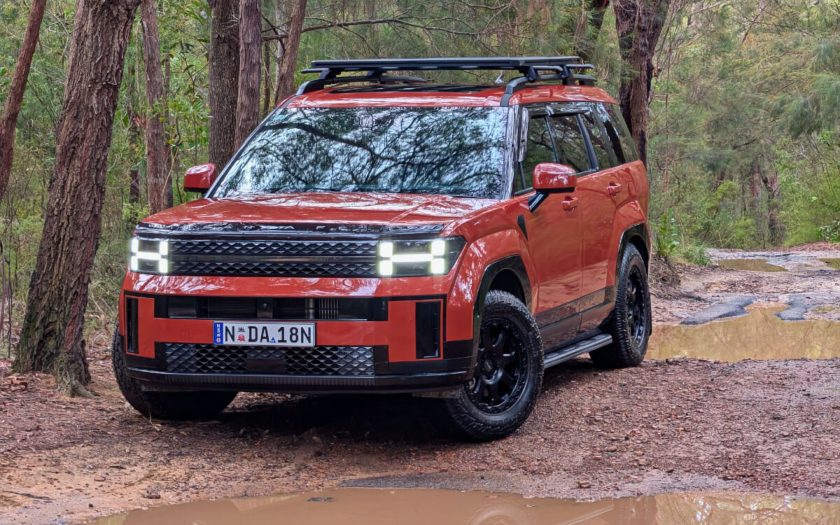Chris Riley tests the 2025 Hyundai Santa Fe XRT Calligraphy Hybrid large SUV with pricing, specs, ride and handling, safety, verdict and everything the over-50 driver needs to know.
Summary: The new Santa Fe XRT Calligraphy appeals right from the start with its snappy styling. Serious off-roaders will probably bypass it in favour of a body-on-frame vehicle such as the Ford Everest.
2025 Hyundai Santa Fe XRT Calligraphy Hybrid large seven-seater SUV
Pricing: from $53,000 (plus on road costs). $93,575 (XRT as tested, driveaway including options)
Options: Pecan Brown Nappa leather $295, XRT Peak Option Pack $9900, XRT Adventure Option Pack $6900, premium paint (any other than white or orange) $750, matte paint $1000, all in one carpet and rubber mats (front and centre rows) $390, cargo barrier (behind second row) $1162, cargo liner (five-seater) $189, cargo liner (seven-seater) $249, fridge/freezer $1299 (25L), $1399 (36L), towbar kit $1501, tailgate bike rack $929, side awning $371
Warranty: Five-years, unlimited kilometre, eight-year warranty (battery), one-year roadside assistance
Safety: Five-star ANCAP (2024)
Engine: 1.6-litre petrol-electric hybrid four-cylinder turbocharged engine, 47.7kW electric motor
Battery: 1.49kWh lithium-ion
Service intervals: 12 months or 10,000km
Power: 172kW @ 5600rpm (combined)
Torque: 367Nm @ 1000-4100 (combined)
Transmission: six-speed auto, front-wheel drive
Body: 4830mm (long); 1900mm (wide); 1720mm (high)
Build country: South Korea
Kerb weight: 2035kg
Towing capacity: 1650kg
Luggage storage: 628L (third row folded), 1949L (second and third rows folded)
Wheels: 18-inch alloy
Tyres: 255/60 R18 Pirelli Scorpion All Terrain
Spare wheel: full size
Ground clearance: 210mm
Approach angle: 19 degrees
Departure angle: 22 degrees
Breakover: 19 degrees
Turning circle: 11.4m
Fuel tank: 67 litres
Claimed consumption: 5.6L/100km (91 RON unleaded)
Consumption on test: 7.8L/100km (1600km)
seniordriveraus consumption on test: 8.3L/100km (268km)
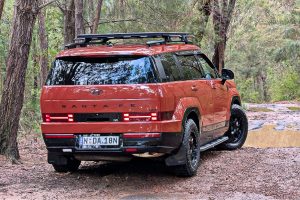
[review]
I still remember the launch of the first Hyundai Santa Fe back in the year 2000, the year that was going to change everything.
Twenty-five years later and now in its fifth generation, the latest version of the family-sized SUV has come a long way since those early days.
The first version was okay, the fourth was pretty damn good and this one is something special, the winner of numerous awards and a wagon that punches way above its weight.
Hyundai describes the boxy newcomer as “open for more”, a rugged yet refined large SUV that seamlessly integrates the demands of family life with the desire for adventure – it’s got something to do with Koreans

What’s it cost?
Priced from $53,000 (the price has grown with the car), available with petrol and hybrid powertrains in either two- or all-wheel drive.
That bottom price gets you the base unnamed version with a 2.5-litre turbocharged four-cylinder petrol engine along with an eight-speed dual clutch-style automatic, and front-wheel drive.
In case you’re wondering, there ain’t no diesel anymore – the hybrid now fulfils this role and pretty well, to a point. As we discovered.
Base petrol with all-wheel drive is another $3000 at $56,000, while the base hybrid with a 1.6-litre turbocharged petrol-engine kicks off at $58,500 – all prices before on-road costs.
The mid-range Elite is priced from $65,000, while our test vehicle, the top of the range seven-seat Calligraphy Hybrid attracts a price tag of $75,000.
But wait there’s more: it was also decked out in Pecan Brown Nappa Leather ($295) as well as the functional but very stylish off-road XRT Peak Option Pack which adds $9990 to the price, bringing the estimated driveaway price to $93,575.06!
The XRT pack adds:
- 17-inch off-road wheels and tyres
- Mudflaps
- Off-road suspension
- Underbody skid plate
- Black side steps
- Roof racks
- Roof platform
- Bonnet protector
- Style visors
Phew! It wasn’t that long ago that the first Hyundai cracked the $70,000 mark with the first Genesis sedan.
Creamy white and Terracotta Orange cost nothing, but anything else is premium paint and adds $750; matte takes it even further, to $1000.
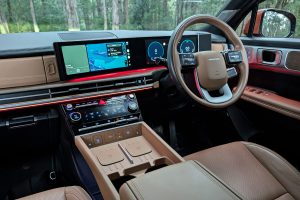
Standard kit at this end of the spectrum includes classy Nappa leather, heated, cooled and power-adjustable front seats with memory and massage for the driver, leather trimmed steering wheel, keyless entry and start plus rear privacy glass.
Zero gravity front seats distribute pressure to provide maximum comfort when taking a break on a drive.
If it sounds swish it is, with two-zone climate control, rear air vents and separate fan controls for the third row, a digital rear view mirror, solar filter windscreen and front-door side glass, customisable mood lighting, UV sanitisation tray that sterilises items and an innovative bi-directional centre console, and a power tailgate that seems to have a mind of its own.
The bi-thingy lets front and second-row passengers open the console to access stored items. How about that?
The Calligraphy also cops two glass sunroofs: large and fixed at the rear and a smaller, retractable, panel at the front.
Infotainment consists of a sweeping display panel that houses two 12.3-inch screens, one for info and the other for instruments, plus a smaller 6.6-inch screen for the aircon, with a speaker tacked on the right end to make the whole thing look even longer.
The system offers voice control, Bluetooth multi-connection, Google fast pairing, user profiles with Bluelink account linking and calendar integration.
There are also themes, blue-light filter, quiet and valet mode, AM/FM and DAB+ digital radio, built-in satellite navigation, wireless Apple CarPlay and Android Auto, plus over the air updates.
The Calligraphy also features a new dual wireless charging pad in the spacious front centre console, to allow the charging of two smartphones at the same time.
Premium 12-speaker Bose audio is fitted, with an external multi-channel amplifier, a front centre midrange speaker, and a subwoofer.
Access to connected services is complimentary for five years.
Five-star safety extends to 10 airbags, head-up display, 360-degree camera and autonomous emergency braking.
The latter is capable of detecting and reacting to vulnerable road users such as pedestrians, cyclists and motorcyclists and operates at speeds from five to 85km/h.
There’s also active cruise control, traffic sign recognition, blind-spot monitoring with active collision avoidance, auto evasive steering assist, lane keeping assist, junction-turning and crossing assist, steering-initiated rear evasive assist and driver attention warnings,
Navigation-based smart cruise control recognises the vehicle ahead using the front-view camera and front radar, and determines the safe speed range for curves ahead using the navigation system.
Santa Fe comes with a five-year/unlimited kilometre warranty, with eight years on the hybrid battery.
Servicing is due every 12 months or 10,000km and you get roadside assistance for 12 months.
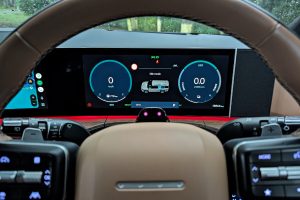
What’s it go like?
Santa Fe is the same width but 45mm longer, with H-shaped (Hyundai) graphic elements.
It’s also 60mm higher than before, with a 50mm longer wheelbase (distance between axles) which translates to more legroom.
Getting in for the first time, the new model feels spacious.
A large centre console has space for two mobiles to charge side by side simultaneously.
The look and feel is upmarket, unexpectedly more than the badge suggests, but we’re not huge fans of the Pecan leather.
It’s a long way back to the two of the seven seats right down the back, with a second-row bench that slides and reclines, and one-touch control to access the third row.
Each of the third-row seats also fold and recline.
Second-row legroom has increased by 20mm, third-row legroom is 15mm.
Hyundai claims 628 litres of cargo capacity with the first two rows of seats in use (the wheel arches obviously intrude as shown).
There’s also a six-seat version for about $525 more, but less is more as they say because it offers easier access to the third row.
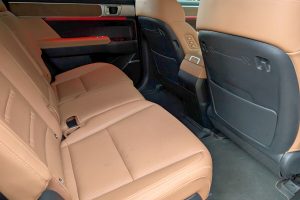
The petrol-electric powertrain consists of a 1.6-litre four-cylinder turbocharged petrol engine and 47.7kW electric motor that draws its power from a 1.49 kWh lithium-ion polymer battery.
Combined output is 172kW of power at 5600 rpm and 367Nm of torque from 1000-4100 rpm, with a conventional six-speed automatic (not dual clutch) that feeds power to all four wheels as required.
This compares with the previous 2.2-litre turbo-diesel that it replaces which produced 148kW of power at 3800 rpm and 440Nm at 1750 rpm.
There are four drive modes (Eco, Normal, Sport, My Drive) as well as three multi-terrain modes (Snow, Mud, Sand).
The dash from zero to 100km/h takes 9.5 seconds and the top speed is 190km/h.
The XRT off-road option pack fitted is a collaborative effort between Hyundai Australia and the Hyundai America Technical Centre.
An Australian team travelled to California to test the existing North American sourced components in varied on- and off-road conditions.
These included steep unsealed climbs and descents with rocks and sand, along with other test work including heavy duty towing, damper tuning and Motor Drive Power Steering (MDPS) assessment.
Among other things, the XRT pack brings 17-inch wheels with chunky all-terrain rubber, together with off-road tuned springs and dampers that lift ground clearance by 30mm to a handy 210mm.
It also improves approach and departure angles: approach (19 degrees), departure (22 degrees) and breakover (19 degrees).
A hidden handle folds out of the C-pillar, providing improved roof access.
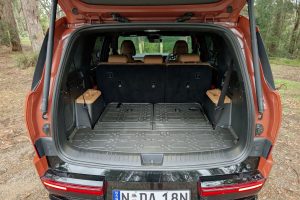
The early Santa Fe was surprisingly good off road, even without low range gearing, keeping up with more fancied 4x4s in all but the most arduous conditions.
It just shows what you can achieve with reasonable ground clearance, decent rubber and a smart four-wheel drive system.
The XRT builds on this heritage, with the makings of something a bit special.
Of course, it poured cats and dogs the day we planned to put the vehicle through its paces on our favourite fire trail.
But it certainly looks the part and a colleague who tried it out on the same trail was impressed with the way the car performed.
It’s more than ready to take on muddy conditions, icy slushy sealed roads and moderately rough dirt tracks – just don’t get too adventurous.
On the downside, a space-saver spare is provided which does not meet the requirements of off-road driving where a puncture is always on the cards.
The hybrid powertrain performs well most of the time, tootling around town, doing the family shop or getting the kids from school.
Under hard acceleration, however, it starts to feel a little underdone. Initial response is good, but after that it begins to fade, sounding more like the hard-working four-cylinder engine that it is – turbocharged or not.
Load it up with kids and a boot full of luggage and the powertrain could really be put under pressure.
Predominantly front-wheel drive, the clever all-wheel drive system is an active system and always sends a percentage of driving force to the rear wheels, rather than waiting for wheelspin like most systems.
There’s a good chance you’re going to want to tow something with your new Santa Fe, so it is important to note that the hybrid is limited to towing a 1650kg braked load.
Steering and handling are surprisingly good, particularly the latter where we would have expected more body roll.
But the busy steering wheel and twist-grip gear selector with its park button on the end will require some mastering.
Mounted below the indicator stalk, they can be confused at times, especially during hurried three-point turns.
With a 67-litre tank, it takes standard 91 unleaded and has claimed fuel consumption of 5.6L/100km.
We were getting 7.8L/100km after about 350km of mixed driving, including dirt and pavement.
The 1600km long term average was also 7.8L/100km.
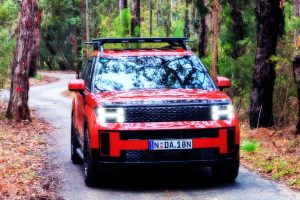
What we like
- All-new look
- Plush interior
- Low fuel consumption
- Lots of connectivity and charging options
- Increased off-road ability
What we don’t like
- Tucked in rear profile
- Awful digital rear-view mirror
- Cluttered steering wheel
- Twist grip column mount gear selector
- Lacks a full-size spare wheel for off-road work
- Head up invisible with polarized sunnies
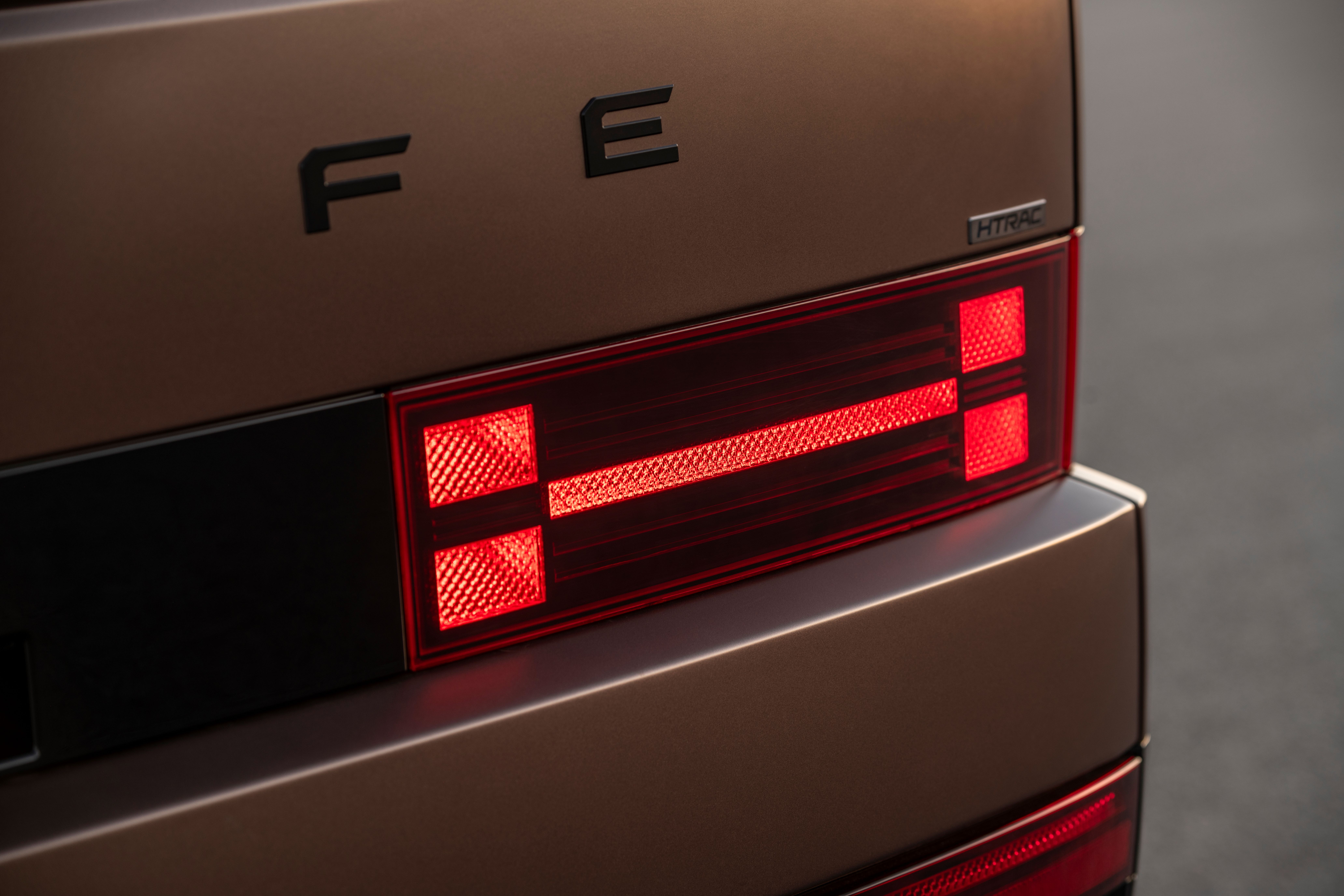 What over-50s need to know
What over-50s need to know
The Santa Fe is an impressive car, especially with the XRT kit fitted.
But the price could be a stopper, at more than $90K by the time you put it on the road.
That’s a long, long way from $36,990 for the top of the range GLS when the Santa Fe was launched here back in 2000 (but it’s a lot more car).
It’s also probably more car than you need, especially if you’re not going to get it dirty.
Otherwise, it’s a lovely vehicle that’s comfortable and easy to drive and doesn’t use much fuel for its size.
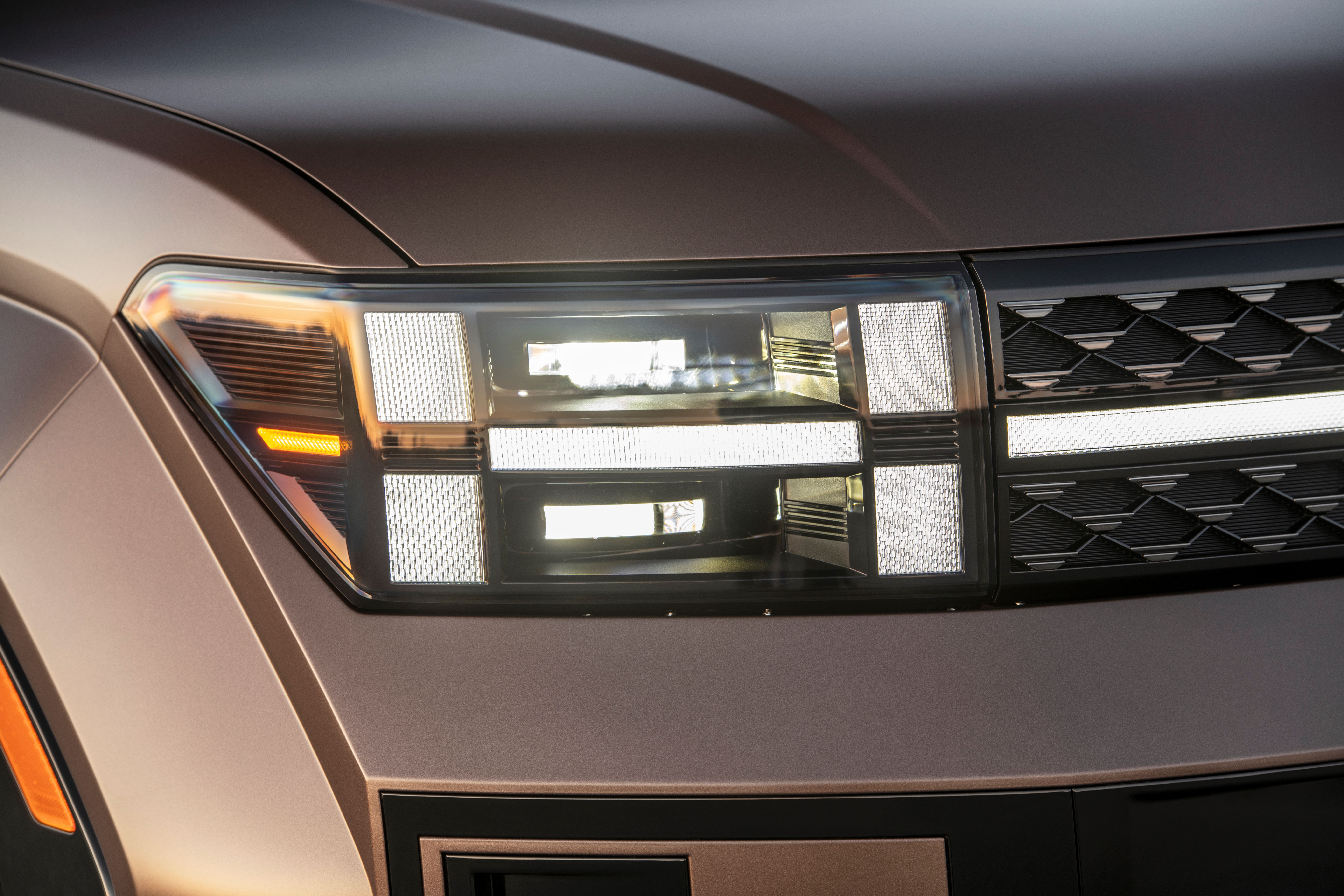
seniordriver comments
The Hyundai Santa Fe XRT Calligraphy Hybrid is an impressive vehicle, but the substantial price will put many buyers off. Let’s face it, over $90,000 is a big ask for any vehicle.
As always, you’ll have to decide for yourself if the $10,000 XRT Pack is necessary for your intended usage pattern. And think carefully about matte paint, if it appeals to you. We’re not sure if it’s still as difficult to maintain as it was in the early days, but if it is, you’ll probably rue the day you chose it.
It seems a little odd that the five-seater version costs $525 more, but if you don’t need all seven seats and you’d like better access to the second row, it may be worthwhile (and certainly a small impost in the overall price equation).
When we checked online, we found that standard wheels are 18-inch (Chris reports them as 17-inch, others have claimed the wheels are 20-inch, with a unique design for the Calligraphy) and we found information that the spare is a full-size wheel and tyre (Chris reports that it’s a space saver). If you’re looking at a Santa Fe, check both to confirm. Another thing to check is the price of the XRT Peak Option Pack (Chris says $9990; we found it at $9900).
Being a monocoque (rather than a ladder-frame) SUV means suspension travel is limited and if you intend to do some serious off-roading, you may find that even the 210mm ground clearance is insufficient.
We quickly tired of the incessant messages appearing on the screen, and especially the one that questioned whether we were paying attention!
